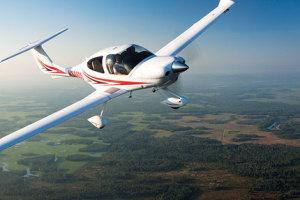 Plane & Pilot Magazine: Diamond DA40 XLS: Premier Edition
Plane & Pilot Magazine: Diamond DA40 XLS: Premier Edition
Premier Aircraft of Fort Lauderdale, Fla., has created its own ultra version of the Diamond DA40 XLS
By Bill Cox, Photos By James Lawrence
Those of us in the aviation press privileged to review new aircraft are sometimes taken to task for not being appropriately critical. The sentiment often seems to be, “If you’re not finding things to dislike, you’re not doing your job.” That’s more of a challenge with some airplanes than others. True, there are a few marginal designs, but some models are just too adorable to dislike. Think a husky puppy in a dog bowl or a kitten with a ball of string.
Or, think a Diamond Star. A few weeks ago at the Sun ‘n Fun Fly-In in Lakeland, Fla., I wished I could take a Star home with me. Flying with Premier Aviation’s Jeff Owen, I had an opportunity to renew acquaintances with the four-seat Diamond, and the experience was equal parts fun and joy.
I’m sorry, all you cynics out there, but the Diamond Star is an absolute ball to fly. Sure, it would be great if it could inhale sky at 3,000 fpm and rip along at Mach .80, but it’s already the fastest certified four-seat single above the planet with only 180 hp bolted to the nose. It’s also the only one with an aft door, the largest back seat, and arguably the quickest handling in the class.
Jeff Owens’ 2011 demonstrator was a special airplane upgraded by Premier Aircraft of Fort Lauderdale, Fla. Premier sells more Diamond Aircraft than any other dealer in the world, so it’s not surprising that they understand what the Diamond customer wants. Strangely, the modified Star is known as the Premier Edition, and it features upgrades in a number of areas. More on the Premier model later.
Esthetically, the basic DA40 is an automatic winner. Anyone who can’t appreciate the sheer grace and beauty of a Diamond Star may need to consider a dog and a white cane. All the Diamond designs are the result of a continuing effort to round off the edges of general aviation. They reflect the shaved-leg smoothness of composite surfaces; semi-sailplane, high-dihedral, high-aspect-ratio wings; waspish empennage and elegant T-tail—all of which lend the Star an aerodynamic elegance, surprisingly uncommon in its class.
Okay, while it’s true a sexy design helps any airplane sell, grading an airplane on looks alone is like ranking NASCAR drivers on their knowledge of Chaucer. Fact is, the Star has the numbers to back up its appearance, and the airplane’s performance and utility are only enhanced by the Premier mods. Jeff Owen explains: “We wanted to offer a package of options to improve a buyer’s choices, and the Premier Edition includes several of those. We made it a point to incorporate functional items as well as comfort and cosmetics features.”
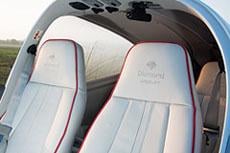
The Premier 1 package offers a PowerPlus standby alternator system for backup electrical power, a new Hartzell three-blade composite propeller and much more.
The basic Premier 1 package includes: 1) a PowerPlus standby alternator system for backup electrical power; 2) a new Hartzell, semi-scimitar, three-blade, composite propeller for better climb and cruise performance; 3) a LoPresti Boom Beam in each wing tip for enhanced night and daytime visibility; 4) improved all-leather, memory-foam upholstery featuring new color choices, piping accents and stitching patterns; 5) new thicker carpet with improved choices; 6) additional exterior striping and 7) Diamond logos embossed on the headrests and a personalized owner plaque on the instrument panel. Price is $16,495.
Finally, especially for their South Florida customers (and denizens of other ultrawarm climates), the Premier group developed an additional option known as Package 2. Premier certified a vapor-cycle air-conditioning system, an automotive-style unit that delivers 55-degree F air at the vent source. The air conditioner adds 60 pounds to empty weight (and deducts a like amount from payload), but if you live in those parts of the world that suffer stifling heat for much of the year, A/C can be more than worth the price.
The whole idea was to offer a buyer the chance to personalize a DA40 for his or her mission. Even with the heavier leather, thicker carpeting and all the other additions, useful load doesn’t suffer adversely, at least in contrast to other four seaters. Skip the air-conditioning option (as Premier did on my demonstrator), and you wind up with an 800-pound useful load, enough for full fuel and 500 pounds for people and stuff.
You climb aboard a Star in what seems an unconventional manner, over the front of the wing. The boarding step extrudes from the fuselage ahead of the wing rather than behind it. This obviously makes it extremely unwise to board with the engine running, but most pilots agree that’s a dumb idea anyway.
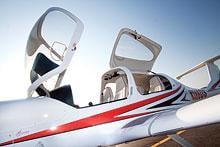 Once you’re on the left wing-walk, you have a choice of two doors for access to the cabin. The main hatch is hinged at the front, and folds up and forward to uncover the two front seats, whereas rear passengers can enter via their own clamshell door at aft left. Perhaps best of all, the pilot can close the door on aft passengers before entering the airplane. The Star is the only four-seat production airplane I know of that offers separate doors for front and rear entry.
Once you’re on the left wing-walk, you have a choice of two doors for access to the cabin. The main hatch is hinged at the front, and folds up and forward to uncover the two front seats, whereas rear passengers can enter via their own clamshell door at aft left. Perhaps best of all, the pilot can close the door on aft passengers before entering the airplane. The Star is the only four-seat production airplane I know of that offers separate doors for front and rear entry.
Seated in the left front, you’re looking out at the longest wings you’ve ever seen in a four-seat single, 39.5 feet from tip to tip. (Check your hangar dimensions before signing the lease.) You’re also straddling a conventional joystick rather than addressing a yoke or a side stick—great fun. You’re enclosed by 26G seats fixed to the floor, but with adjustable rudder pedals. The stick isn’t adjustable for fore-aft travel, by the way, so you had best hope your arms are the right length. The cabin also features seat-belt air bags for greater crash protection, and the airplane boasts one of the best safety records of any single. It may be heartening that the Star is one of the very few (only?) composite aircraft without an airframe or wing-life limit.
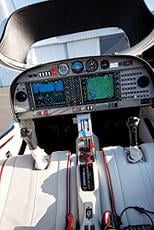
The DA40 features separate doors for front and rear entry (opposite), offering passengers easier access to the back seats. In the cockpit, a conventional center stick is nicely harmonized between ailerons and elevator.
The Star’s cabin is unusual in that the fuselage is slightly bowed abeam the rear seats, so the aft cabin is actually wider than the front. It measures 43.5 inches across, while the front is 42 inches wide, about the same dimension as a 36 Bonanza or 58 Baron.
Jeff Owen and I were flying on a lukewarm day in early April, but it’s obvious the optional air-conditioning system could be invaluable for flying in southern Florida, in temperatures above 25 degrees C. The DA40’s glass hatch offers plenty of visibility of the outside world, but a semi-bubble canopy is a two-edged sword. A warm cockpit is the price you pay for such an excellent view outside. Premier suggests the A/C is available as a retrofit on any Diamond DA40 for about $30,000, installed at the company’s shop in Fort Lauderdale Exec, and I’ll bet they’ll have some takers.
I was brought up on full-castering tailwheels, so the Star’s nonsteerable nosewheel makes me feel right at home. True, asymmetric braking is the only way to steer, a minor maintenance concern, but the system allows the airplane to maneuver within its own wingspan, an invaluable asset on a crowded ramp.
At 2,645 pounds gross with only 180 hp out front, the Star doesn’t exactly scamper down the runway, but the glider-like wing requires less than 1,200 feet to lift the airplane into the sky. On the way uphill, expect to see an easy 800 fpm flying heavy, 1,000 fpm flying light.
Diamond claims a service ceiling over 16,000 feet, and considering the manufacturer’s legacy of building pure and powered sailplanes and the wing’s high aspect ratio (the proportion between wingspan and average wing chord), that’s probably not far off the mark. In fact, the design is fairly efficient up high, a good thing, since the 50-gallon fuel capacity leaves the Star a little short on IFR range. Standard fuel is 40 gallons, but we’re told virtually every buyer opts for the 50-gallon tanks (contained in aluminum fuel cells mounted between the wings’ carbon-fiber wing spars).
An obvious benefit of the DA40’s composite structure and slick aerodynamics comes in cruise. Up at 7,500 feet on an ISA day with the black knob against the wall, the little Lycoming typically sips 10 gph while tripping along at 145-147 knots. The Star does a good job at higher altitudes as well, and many pilots prefer to cruise at 10,500 or 11,500 feet whenever the wind will allow.
Some models are just too adorable to dislike. Think a husky puppy in a dog bowl or kitten with a ball of string.
In short, the Star offers impressive cross-country performance, at least five knots better than the efficient Grumman Tigers, and easily the equal of some ’70s-vintage, 200 hp retractables (Piper Arrow, Beech Sierra, Cessna Cardinal RG, Commander 112). In combination with the Lycoming’s miserly fuel burn, the Star yields almost 17 statute mpg, better economy than most Escalades or Navigators, and more than twice as fast.
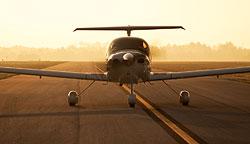 The debate between advocates of side sticks, conventional center sticks and yokes will probably never be resolved, but my vote goes to center sticks. The DA40’s stick is nicely harmonized between ailerons and elevator, with enough roll to make handling sporty without so much pitch that the airplane becomes twitchy. There’s no slop in the Star’s controls, as pushrods connect the controls to the stick.
The debate between advocates of side sticks, conventional center sticks and yokes will probably never be resolved, but my vote goes to center sticks. The DA40’s stick is nicely harmonized between ailerons and elevator, with enough roll to make handling sporty without so much pitch that the airplane becomes twitchy. There’s no slop in the Star’s controls, as pushrods connect the controls to the stick.
Back in the pattern, the Star is happy at any approach speed between 65 and 80 knots. Dirty stall with flaps extended to their full 42-degree limit is a low 49 knots, so technically, you could meet the 1.2 Vs requirement with an approach at only 59 knots. That might be a little sporty unless you know the airplane VERY well, but 65 knots should provide a reasonable flare with plenty of roll control remaining.
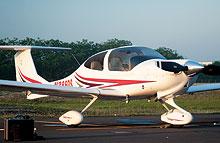 That’s assuming you could find a way to slow the airplane. Go-down/slow-down can be a definite challenge. Glide ratio is 11:1, half again the L/D of most fixed-gear singles. The smooth, composite construction and semi-sailplane, Wortmann FX 63-137 airfoil result in an unusually efficient design. Rough calculation suggests a drag coefficient on the order of .020, only slightly less efficient than the aerodynamic paragon of general aviation, the LoPresti Fury (at .0188). Max flap speed is 106 knots, so flaps don’t help much during descents. The airplane could benefit from installation of speed brakes, not currently an option, and a difficult STC considering the Star’s composite wing structure.
That’s assuming you could find a way to slow the airplane. Go-down/slow-down can be a definite challenge. Glide ratio is 11:1, half again the L/D of most fixed-gear singles. The smooth, composite construction and semi-sailplane, Wortmann FX 63-137 airfoil result in an unusually efficient design. Rough calculation suggests a drag coefficient on the order of .020, only slightly less efficient than the aerodynamic paragon of general aviation, the LoPresti Fury (at .0188). Max flap speed is 106 knots, so flaps don’t help much during descents. The airplane could benefit from installation of speed brakes, not currently an option, and a difficult STC considering the Star’s composite wing structure.
If descents are a challenge, landings are exactly the opposite, almost silly simple. You could probably coach Betty White through a solo in a half-dozen hours. The flare seems nearly automatic, and the touchdown is anticlimactic. Few airplanes are easier to land than a Cessna Skyhawk or Piper Archer, but the Diamond Star may be one of them.
Add it all up, and it all adds up. Every aircraft design represents a series of compromises, but the folks at Diamond seem to have compromised the least. The DA40 XLS gets my vote as the best, all-around, 180 hp, fixed-gear people hauler above the planet.
Diamond DA50 SuperStar
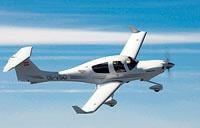 The Diamond SuperStar was a design exercise initiated in 2006 to explore the possibility of a fixed-gear, super-single based on the company’s popular DA40 Star. The airplane employed a FADEC-managed, twin-turbocharged, 350 hp Continental TSIO-550J, and it was intended as a competitor with the Cirrus SR22, Columbia 400 and Mooney Acclaim. Diamond was riding high at the time with its DA20, DA40 and DA42 aircraft selling well, and the company hoped the new aircraft would give them a foothold on a new market.
The Diamond SuperStar was a design exercise initiated in 2006 to explore the possibility of a fixed-gear, super-single based on the company’s popular DA40 Star. The airplane employed a FADEC-managed, twin-turbocharged, 350 hp Continental TSIO-550J, and it was intended as a competitor with the Cirrus SR22, Columbia 400 and Mooney Acclaim. Diamond was riding high at the time with its DA20, DA40 and DA42 aircraft selling well, and the company hoped the new aircraft would give them a foothold on a new market.
The original concept was for two similar airplanes, the 350 hp SuperStar and a 170 hp Thielert diesel version, the Magnum, both to be certified with five seats. The SuperStar was expected to offer a flight-level cruise of 200 knots. Both projects were put on hold when the economy turned asthmatic in 2009. Diamond was concentrating its assets on developing the Diamond D-Jet at the time. With the recent success of the Cirrus SR22 and Cessna’s acquisition of the Columbia line three years ago, Diamond may be taking the DA50 off the shelf in the next few years.
Diamond D-Jet: Still in the VLJ Hunt
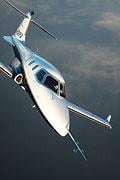 Was it really only a half-dozen years ago that there were nearly a baker’s-dozen VLJs pro-posed or under development? It seemed every-one had a small jet on the drawing board in those days. Now, most of those airplanes have been relegated to the dust bins of history. At this writing, there are only three that are still under active development: the Piper Altaire, Cirrus Vision and Diamond D-Jet, all more-than-coincidentally single-engine airplanes. (The Cessna Mustang and Embraer Phenom 100 are certified and flying, but they’re hardly VLJs. The Eclipse 500, though certified, is still a question mark, and the Honda Jet’s seating capacity (seven), speed (420 knots) and price ($4.5 million) will place it well out of the VLJ class.)
Was it really only a half-dozen years ago that there were nearly a baker’s-dozen VLJs pro-posed or under development? It seemed every-one had a small jet on the drawing board in those days. Now, most of those airplanes have been relegated to the dust bins of history. At this writing, there are only three that are still under active development: the Piper Altaire, Cirrus Vision and Diamond D-Jet, all more-than-coincidentally single-engine airplanes. (The Cessna Mustang and Embraer Phenom 100 are certified and flying, but they’re hardly VLJs. The Eclipse 500, though certified, is still a question mark, and the Honda Jet’s seating capacity (seven), speed (420 knots) and price ($4.5 million) will place it well out of the VLJ class.)
On the premise that less may be more, Diamond is deliberately aiming low with the D-Jet. It’s perhaps the least ambitious of the VLJs, intended to sell for less than $1.5 million. Diamond hopes to certify the D-Jet at only 25,000 feet rather than the more typical 35,000 feet, and the target cruise speed has been set at 315 knots, burning about 70 gph. With 5.5 psi pressurization at its proposed certified max altitude, the D-Jet should provide an 8,000-foot cabin for up to five occupants at max altitude.
Diamond recently announced that it has obtained commitment for a significant investment exclusively dedicated to the D-Jet development program. This investment will enable Diamond to recall furloughed engineering and technical staff, resume flight-test operations and proceed toward building the next test aircraft, subject to finalization of closing arrangements.